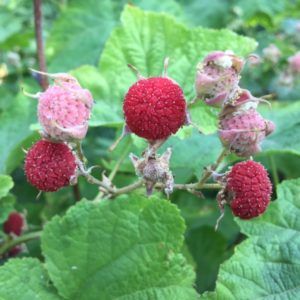

Bryon Jessop
Bryan Jessop is a professional forager, owner of Morchella Foods, and wild food enthusiast. His wild berries, mushrooms, greens, and edible flowers can be found on the menus of some of San Francisco’s finest restaurants. Check out his website and Instagram to see what sustainable wild foods are in-season and in-demand from SF’s top chefs.
I just got back from the Sierra Nevada mountains where one thing is clear: it’s berry season. As I rumbled down dirt logging roads I passed elderberry bush after bush with branches sagging under the weight of their fruit. At my first stop I was picking thorny gooseberries by the leather-gloved handful. Then it was the golden currants and thimbleberries that finally presented me with the forager’s dilemma – too much fruit, too little time.
You may have noticed that the prices of your favorite little fruits are bottoming out right now, and that means conditions are ripe for berries. And while jumbo-sized GMO strawberries are an impressive triumph over nature and we all love the convenience of frozen blueberries, no farmed berry can compare to the intensity of flavor of its wild ancestor. Anyone who has tasted a wild strawberry or eaten a handful of ripe huckleberries can attest to that. In the process of designing berries for size and yield, we’ve sacrificed flavor and nutrition.
Berries taste good. In fact I would argue that they’re some of the tastiest natural foods out there. It’s why we flavor our candies and pies like them. And maybe there’s an evolutionary reason that we adore these flavors. Nutritionists will often point out the astonishing health benefits of berries, which are packed with brain-boosting antioxidant phytonutrients. Did you know that a single serving of farmed blueberries has as much antioxidants as five servings of broccoli or carrots? Now consider that a wild blueberry or huckleberry is smaller, which means more skin to volume and more antioxidants still. Top that with research showing that wild fruit is much higher in fiber, protein, vitamin C, calcium, iron, magnesium, and phosphorous, and you’ve got a pretty compelling case for picking those berries that are mostly left for the birds. In short, wild berries are superfoods.
So what’s out there right now? Blackberries must be the best known and most widely collected. Many of us know the joy of popping a sun-ripened blackberry straight off the vine and into your mouth. But northern California is host to a number of other wild berries. A partial list would include elderberries, thimbleberries, salmonberries, chokecherries, black and golden currants, Sierra gooseberries, white stemmed raspberries, wild grapes, wild strawberries, and both red and evergreen (aka purple) huckleberries. As the summer sun bakes our California landscapes, wild spaces become candy shops full of diverse and delightful treats.
I’ve been learning about some of the lesser-appreciated California berries as part of my venture to provide chefs with extraordinary local foods:

Thimbleberries look like red raspberries at first glance and actually they taste a bit like them too, but a more concentrated version. The vines with five-lobed leaves are ubiquitous both on the California coast and in the Sierras, but finding the berries is less common. The thin-fleshed fruit rests delicately on top of its round bud like a thimble. The fruit is delicate, slow to collect, difficult to transport, and doesn’t store very well. This makes it a forager’s berry, a berry to be eaten right off the bush. I like to crush them against the roof of my mouth and savor their single drop of heavenly nectar as it spreads across my tongue.
Currants and gooseberries are some of the most common and widespread fruits in the Sierra Nevadas. Native peoples used to collect them in large quantities to process into pemmican – the original energy bar made from dried meat and berries. Both the leaves and berries of currants are tacky and fragrant. Once you identify one species of currant you’ll start seeing them all over. Their unique flavor and aroma – somewhere between a raison and black licorice – is unmistakable and makes them easy to ID. The leaves of currant bushes have the same scent, which gives them culinary value as well.



Sierra gooseberry is a low-lying shrub that’s related to currants. However unlike currants, the spiny skin of gooseberries means they need to be collected with thick gardening gloves and pulverized before eating.
OK, now I want to talk about elderberries. These may be the most abundant, unappreciated berries in California. The first thing you need to know is that the leaves, stems, and under-ripe berries are mildly toxic. Many sources suggest that even the ripe berries shouldn’t be eaten raw, but I’ve never had any problem eating small handfuls right off the bush. In fact, the flavor can vary significantly from bush to bush so I prefer to taste them before I start filling my pack. Good berries will be bright but not sour, like a mildly sweet blueberry, but with a subtle pungency. On rare occasions, I’ve encountered elderberries so pungent that I spit them out. But if you catch them at the right stage, a single berry cluster can weigh over a pound and even a small bush may have dozens of ripe clusters. How much do you need? It depends. To make a pint of shrub, only about a cup. For a gallon of wine, you’ll need at least 5 pounds of cleaned berries.

Elderberry shrub is a classic preparation and very simple to make. A shrub is a vinegar-syrup. Just combine 1 cup crushed elderberries with 1 cup apple cider vinegar. Let it sit overnight to infuse the vinegar, then strain into a pot and add 1 cup sugar. Boil long enough to dissolve the sugar, then bottle and store indefinitely in the fridge. Mix it into sparkling water for a refreshing summer drink or use it straight in place of balsamic.
As with any craft, the process for making elderberry wine is only as complicated as the skill of the artisan allows. I’m a novice to fermentation, so I’m trying a simple recipe from Los Angeles forager Pascal Baudar’s book The New Wildcrafted Cuisine. The ingredients are elderberry juice, water, sugar, yeast, and time – it should be ready to drink in about a year.
While it typically takes only a few minutes at the right bush to collect your fill of elderberries, most wild berries are far less forgiving.
Consider the delectable huckleberry. By the middle of August, huckleberries are beginning to ripen on our foggy north coast. While at the peak of the season it can look like a veritable smorgasbord, just try collecting enough for a single pie. Picking huckleberries in any large quantity can be daunting – I can get about 2 lbs per hour when I’m in a flow state. Cleaning them can be tedious and takes equally long.
Are huckleberries really worth all this trouble? Yes. Yes they are. Personally I can never get enough – I would eat my weight in huckleberries each year if I could afford it. Not only are they my favorite-tasting berry and one of my all-around favorite foods, they are truly one of the healthiest foods we can eat. Last season I was lucky to meet a forager on the Oregon coast who sold me his haul. Even the forager-direct price would have been astronomical for any domesticated berry, but having gathered and processed them myself I knew I got a great deal. This season I’ll buy all I can get my hands on for chefs and friends who want to supplement their take. Maybe I’ll even splurge and make a huckleberry pie.
Many people are content to munch on a few berries as they hike, but for those who want to satisfy their huck cravings year-round, here are some tips for obtaining a larger harvest:

Equipment. Good foraging attire is a must. It can be wet in the fog, and once you get into it you may find yourself crawling over thickets of vegetation to get the best vantage on a productive bush. I wear long pants, ankle-high boots, a long sleeved shirt or jacket, and a hat. For your berry repository, I recommend a large bucket or tub that you can hang around your shoulders by a strap or rope. This will free your hands to work the berries, and the larger the bucket, the fewer berries you’ll lose to the ground.
- Timing and location. Wait to harvest until most of the berries are ripe, typically August through October. Huckleberry bushes are common along the coast, especially with bishop pine. The trick is finding bushes that produce berries, and for that they need sunlight. Look for clearings and edges of forested areas, then hone in on the bushes that are the most prolific berry producers.
- Technique. I’ve learned of two main techniques for getting these berries into your bucket: tickling and spanking. Tickling is the process of working your way along the branches and dislodging the ripe berries using all your fingers. It’s a bit slower but results in less debris (read: less cleaning) than spanking. Spanking is the technique of hitting the branches with your hand to loose the berries into your bucket. You have to calibrate the force of your spanks – too many green berries means you’re hitting the bush too hard, not enough ripe berries means you need to spank a little harder. Most importantly, whatever technique you choose, don’t forget to eat the berries as you pick.
- Cleaning. To clean my huckleberries, first I fill the collecting bucket/tub with water. Most of the berries will sink while debris (dried flowers, leaves, insects, etc.) float to the top. Scoop out the floating debris and your berries will already look dramatically better. If you have access to a huckleberry ramp, now is the time to use it. When you pour your haul down a gentle incline, the round berries will roll to the bottom, leaving a lot of debris and mushy berries behind. The final step is the manual process of picking out the remaining green and rotten berries, large stems and any remaining debris by hand. I tolerate the small stems and some under-ripe berries, and would even argue that they enhance the flavor with complex bitterness and forest notes.
- Storage: A bowl full of freshly cleaned huckleberries is a wonderful thing to behold. It looks like berry caviar. The berries will last at least a week in refrigeration, but I immediately freeze what I know I want to store. Lay them out in a single layer on a sheet pan to freeze so they don’t stick together, then transfer to plastic bags or tubs.
I love sharing my foraged finds with others, but I’ll admit I get stingy when it comes to huckleberries. I set aside a small amount to be eaten fresh, then stash the rest away in the freezer. Throughout the year, I’ll thaw them out one handful at a time and put them in my morning granola, cereal, and pancakes – any time I think I need a boost of nutrition or when I’m feeling worthy of a hard-earned treat.
What’s your favorite wild berry? Any harvesting tips or recipe ideas? Let me know!
Wild-Harvested Baobab Fruit
The naturally pre-biotic containing baobab fruit is the perfect addition to your berry harvest. Its pectins make it a natural thickener and a great addition to chutneys ad

